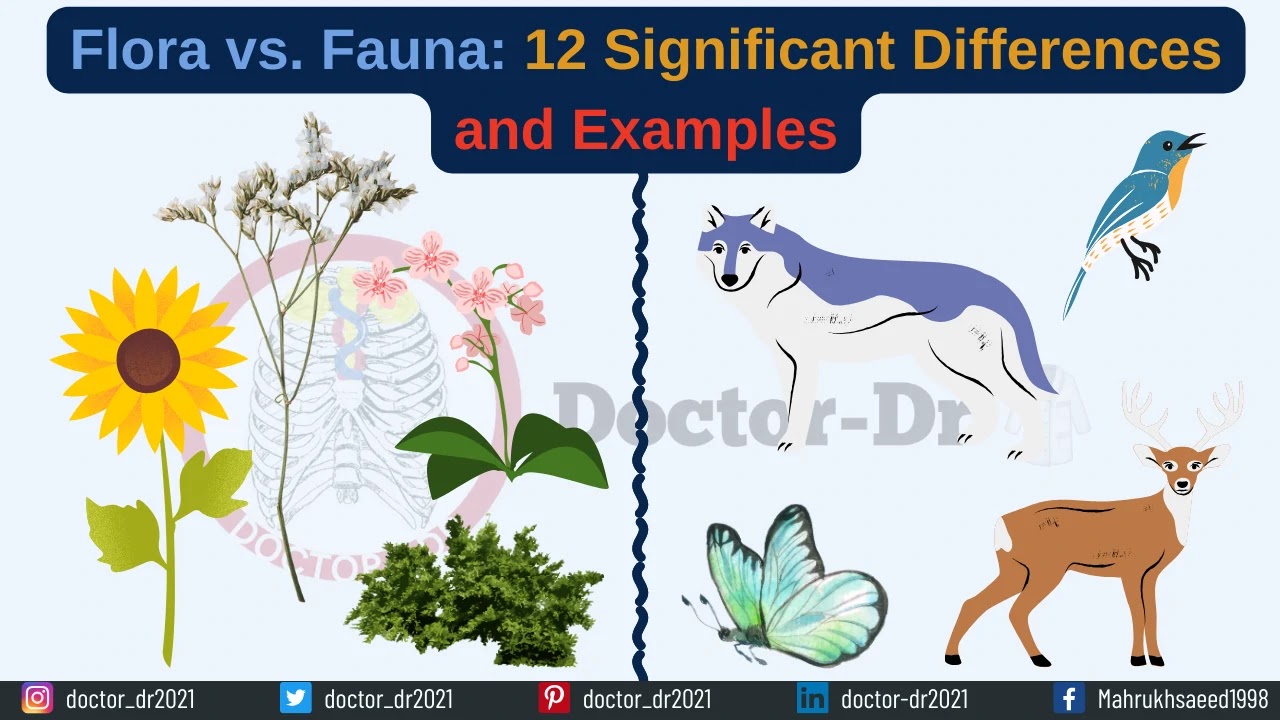Table of Contents
- Flora Definition
- Fauna Definition
- Key Differences (Flora vs Fauna)
- Examples of flora
- Examples of fauna
- Read Also: 15 differences between amphibians and reptiles
Flora Definition
- On occasion, the terminology "microflora" or "gut flora" is employed to denote the inherent microorganisms, primarily bacteria and fungi, residing within various organisms.
- The word "flora" finds its roots in the Latin appellation of the Roman Goddess of plants, known as "Flora."
- Diverse plant species are systematically categorized into different floras based on various criteria, including geographical location, often referred to as "floristic regions," climatic conditions, environmental factors, and historical periods.
- Floristic regions can encompass a wide array of habitats, ranging from mountainous terrain to valleys, while historical periods may pertain to the plant life of bygone eras, such as fossilized flora, or the contemporary flora. These categories are subsequently subdivided based on specific ecological niches.
- Prominent types of flora encompass native flora (plants naturally occurring in a particular region), agricultural and horticultural flora (plants cultivated by humans), and weed flora (comprising unwanted and undesirable plant species, although some within this category may have traditional benefits in other ecosystems).
- Additionally, the term "Flora" serves as a means of documenting the plant life within a designated area or time frame. Historically, such documentation took the form of books, but nowadays, it is readily accessible through websites.
Fauna Definition
- The term "fauna" draws its inspiration from various sources, including "Fauna, the Goddess of earth and fertility," the Roman God "Faunus" from Roman mythology, and the associated forest spirits known as "Fauns."
- Similar to flora, fauna undergoes systematic categorization based on a multitude of criteria, including geographical location, characteristics, climatic conditions, environmental circumstances, and historical periods.
- Among these classifications, the most prevalent is rooted in geographic regions. Some examples of region-based classifications include cryofauna (animals inhabiting cold regions), cryptofauna (animals concealed or dwelling in protected habitats), epifauna (animals residing at the seabed's surface), and infauna (oceanic animals dwelling beneath sedimentary or depositional layers).
- Additional region-based categorizations include macrofauna (soil-dwelling animals retained on a 0.5 to 0.3 mm sieve), megafauna (large animals inhabiting a specific region or era), meiofauna (invertebrates larger than microfauna but smaller than megafauna), and microfauna (microscopic animals or invertebrates).
- Specific terms such as avifauna (encompassing birds) and piscifauna (including fishes) delineate particular animal groups within the broader concept of fauna.
Key Differences (Flora vs Fauna)
|
Comparison Basis |
Flora |
Fauna |
|
Definition |
Flora encompasses all
naturally occurring native plants within a specific region. |
Fauna constitutes the
entirety of animal life present within a particular location or during a
specific time period. |
|
Classification |
Flora is categorized into
native flora, agricultural and horticultural flora, and weed flora. |
Fauna is classified into
categories such as cryofauna, cryptofauna, infauna, epifauna, macrofauna,
megafauna, meiofauna, and microfauna. |
|
Inclusion |
Flora encompasses all plant
species. |
Fauna encompasses all animal
species. |
|
Study |
The study of flora is termed
'Botany.' |
The study of fauna is termed
'Zoology.' |
|
Nutrition |
Flora consists of autotrophs
capable of producing their own food and energy. |
Fauna comprises heterotrophs
reliant on plants for their food and energy. |
|
Ecological Role |
Plants in flora function as
the primary producers in an ecosystem. |
Animals in fauna act as
consumers within an ecosystem. |
|
Locomotion |
Flora includes stationary
plants. |
Fauna comprises mobile
animals. |
|
Evolution |
Flora is considered to have
appeared before fauna in evolutionary history. |
Fauna is thought to have
evolved after flora, according to evolutionary theories. |
|
Cell Wall |
Plant cells in flora possess
a cell wall. |
Animal cells in fauna lack a
cell wall. |
|
Chloroplasts |
Chloroplasts, involved in
food production or storage, are present in flora. |
Fauna lacks chloroplasts and
stores energy in mitochondria. |
|
Climate |
Flora is influenced by the
climate of a region. |
Fauna can impact the climate
of a region. |
|
Examples |
Examples of flora include
flowering plants, grass, and forests. |
Examples of fauna encompass
reptiles, birds, insects, and fish. |
Examples of Flora:
Flowering Plants:
- Flowering plants are the most abundant green plants on Earth, known for bearing flowers.
- They thrive in diverse environments worldwide, spanning from mountains to deep-sea surfaces to arid deserts.
- These plants, termed angiosperms, encompass a variety of forms, including trees, shrubs, and herbs.
- Flowering plants possess specialized vascular tissues, namely xylem and phloem, facilitating the transport of water, minerals, and nutrients to different parts of the plant.
- They are a fundamental component of various ecosystems, although their native habitats may vary.
- Terrestrial flora includes roses, mustard, apples, tomatoes, cauliflowers, etc., while aquatic flora comprises water lilies, hyacinths, lotus, water iris, etc.
Non-Flowering Plants:
- Non-flowering plants, also known as gymnosperms, are characterized by their lack of flowers and the presence of exposed seeds, often in cone form.
- Similar to flowering plants, they possess specialized vascular tissues (xylem and phloem) for the transport of water, minerals, and nutrients.
- Unlike flowering plants, gymnosperms do not produce fruits to cover their seeds; instead, the seeds remain uncovered within cones.
- Non-flowering plants are found across various ecosystems, adapting to different environments.
- Terrestrial flora includes pines, cycads, aloe, cacti, etc., while aquatic flora consists of ferns, mosses, hornworts, etc.
Examples of Fauna:
Amphibians:
- Amphibians are a category of animals known for their ability to inhabit both aquatic and terrestrial environments.
- Currently, there are approximately 8,100 species of amphibians distributed worldwide.
- A distinctive characteristic of amphibians is their moist skin, which supports cutaneous respiration. Some, like terrestrial salamanders and frogs, may even lack lungs.
- Amphibians are considered highly susceptible to environmental changes due to their semi-permeable skin and porous eggs.
- Common examples of amphibians within the Earth's fauna include frogs, salamanders, toads, and caecilians.
Reptiles:
- Reptiles are terrestrial animals characterized by epidermal scales covering part or the entire surface of their bodies.
- While most reptiles are tetrapods possessing two pairs of limbs, they are exclusively terrestrial and lack an aquatic larval stage. However, some reptiles are limbless and live as crawling animals.
- Certain reptiles, such as turtles and tortoises, may have modified limbs in the form of flaps that aid them in swimming.
- There are currently over 10,000 known species of reptiles inhabiting Earth.
- These animals exhibit a wide range of structural diversity and occupy various habitats. Extinct reptiles display even greater diversity, from aquatic plesiosaurs to carnivorous terrestrial dinosaurs, spanning an array of ecosystems.
- Common reptiles found in the Earth's fauna include snakes, crocodiles, lizards, and turtles.








